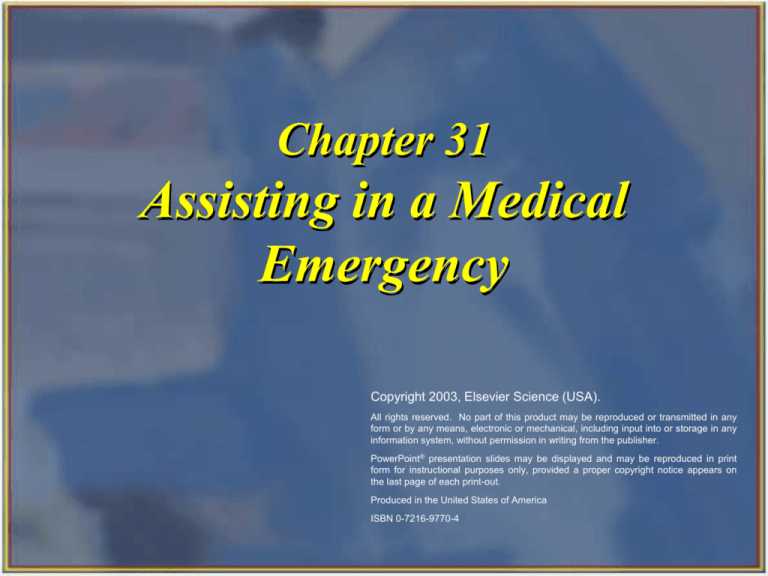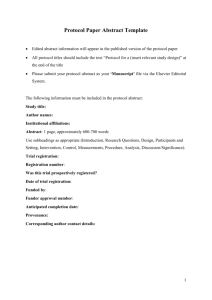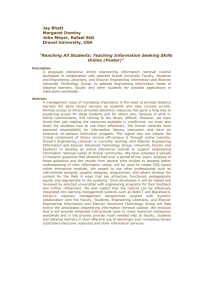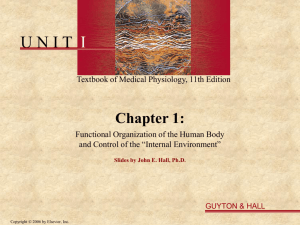
Chapter 31
Assisting in a Medical
Emergency
Copyright 2003, Elsevier Science (USA).
All rights reserved. No part of this product may be reproduced or transmitted in any
form or by any means, electronic or mechanical, including input into or storage in any
information system, without permission in writing from the publisher.
PowerPoint® presentation slides may be displayed and may be reproduced in print
form for instructional purposes only, provided a proper copyright notice appears on
the last page of each print-out.
Produced in the United States of America
ISBN 0-7216-9770-4
Copyright 2003, Elsevier Science (USA). All rights reserved.
Introduction
A medical emergency is a condition or
circumstance requiring immediate action for
someone that has been injured or has suddenly
taken ill.
Copyright 2003, Elsevier Science (USA). All rights reserved.
Preventing an Emergency
Know Your Patient!
• Open communication
• Updated medical history
Copyright 2003, Elsevier Science (USA). All rights reserved.
Emergency Preparedness
Assigned roles
Front desk staff
• Call for emergency services
• Stay on line with emergency services
• Respond to patients in reception area
Copyright 2003, Elsevier Science (USA). All rights reserved.
Emergency Preparedness- cont’d
Clinical staff
• Remain with patient
• Respond to other patients in office
• Provide medical assistance
Dentist
• Assess patient
• Provide medical care
Copyright 2003, Elsevier Science (USA). All rights reserved.
Emergency Preparedness- cont’d
Routine drills
• Training with “mock emergency”
• Learn each other’s roles
Emergency telephone numbers
• 911
• Local police
• Local fire station
• Emergency medical service
Copyright 2003, Elsevier Science (USA). All rights reserved.
Recognizing a Medical Emergency
Symptom: Something that the patient tells
you regarding what he or she feels or is
experiencing.
Sign: Something that you observe in a
patient, such as a change in skin color or an
increased respiration rate.
Copyright 2003, Elsevier Science (USA). All rights reserved.
Emergency Care Standards
Each member of the dental team must be
current in:
• Cardiopulmonary resuscitation (CPR)
• Heimlich maneuver
• Taking and recording of vital signs
Copyright 2003, Elsevier Science (USA). All rights reserved.
Heimlich Maneuver
1. Make a fist with one hand, and place thumb
2.
3.
side of hand against the patient’s abdomen,
just above the belly button, and below the
xiphoid process of the sternum.
Grasp the fist with the other hand, and
forcefully thrust both hands into the abdomen,
using an inward and upward motion.
Repeat these thrusts until the object is
expelled
Copyright 2003, Elsevier Science (USA). All rights reserved.
Table 31-1: Emergency Supplies and Equipment
Copyright 2003, Elsevier Science (USA). All rights reserved.
Specialized Equipment for Emergencies
Automated external defibrillator (AED)
• Function
• Monitors the heart rhythm.
• Analyzes the heart rhythm for ventricular
fibrillation.
• Automatically defibrillates.
Copyright 2003, Elsevier Science (USA). All rights reserved.
Emergency Responses
Physical changes
•
•
•
•
•
Unconsciousness
Altered consciousness
Respiratory distress
Convulsions
Chest pain
Copyright 2003, Elsevier Science (USA). All rights reserved.
Emergency Care Standards- cont’d
Cardiopulmonary resuscitation (CPR)
ABCs of Basic Life Support
• Airway must be opened and maintained.
• Breathing must be evaluated.
• Circulation must be monitored to
determine whether the heart is beating.
Copyright 2003, Elsevier Science (USA). All rights reserved.
Adult CPR
1. Approach victim and check for signs of circulation.
2. If no response, get assistance and call 911.
3. Tilt the victim’s head and lift the chin. Look, listen and
4.
5.
6.
7.
8.
feel for signs of breathing.
If there are no signs of breathing, begin rescue
breathing.
Give two full breaths.
Place the heel of your hand on the chest midline over
the sternum.
Give 15 compressions, making sure to depress the
sternum 1½ to 2 inches for an adult victim.
Complete three more cycles of 15 chest compressions
and 2 breaths.
Copyright 2003, Elsevier Science (USA). All rights reserved.
Child CPR
CPR procedure is essentially the same as for the
adult, with a few specific techniques.
1. For rescue breathing, give one breath every 3
seconds.
2. The hand position is the same as for the adult
chest compressions, but use only the heel of
one hand to compress the sternum 1 to 1½
inches.
3. The ratio for breaths and chest compressions
change to five compressions to one breath.
Copyright 2003, Elsevier Science (USA). All rights reserved.
Infant CPR
1. For rescue breathing, give one breath every 3
2.
3.
4.
5.
seconds.
Breaths are given through both the nose and
mouth.
To complete chest compressions, place the
middle fingers in the center of the chest
between the nipples, remove the index finer.
Compress the sternum ½ to 1 inch.
The ratio for breaths and chest compressions
change to five compressions to one breath.
Copyright 2003, Elsevier Science (USA). All rights reserved.
Common Medical Emergencies
Syncope: A reduced blood flow to the brain
causing the patient to lose consciousness.
• Psychological factors: Stress and apprehension,
fear, the sight of blood or instruments.
• Physiological factors: In one position for a long
time, confined, skipping meals or hungry, and
fatigue or exhaustion.
Postural hypotension: Lack of sufficient blood
flow to the brain that may occur in a patient
immediately after a sudden change in positioning.
Copyright 2003, Elsevier Science (USA). All rights reserved.
Table 31-2: Responding to the Unconscious Patient
Copyright 2003, Elsevier Science (USA). All rights reserved.
Cardiac Emergencies
Angina pectoris: Patient feels severe chest pain
because the heart muscle is deprived of adequate
oxygen.
• Pain from angina usually lasts 3 to 8 minutes.
• Angina pain is relieved or eased promptly by the
administration of a commonly prescribed drug,
nitroglycerin.
Acute myocardial infarction: Commonly referred
to as a heart attack, the muscles of the heart are
damaged because sufficient oxygen is not able to
reach them.
Copyright 2003, Elsevier Science (USA). All rights reserved.
Table 31-3: Responding to the Patient with Chest Pain
Copyright 2003, Elsevier Science (USA). All rights reserved.
Cerebrovascular Accident
Stroke is the interruption of blood flow to the
brain that lasts long enough to damage the brain
and results in the loss of brain function.
Predisposing diseases
• Arteriosclerosis
• Heart disease
• Uncontrolled high blood pressure
Copyright 2003, Elsevier Science (USA). All rights reserved.
Table 31-4: Responding to the Patient Experiencing a Stroke
(CVA)
Copyright 2003, Elsevier Science (USA). All rights reserved.
Breathing Problems
Hyperventilation: An increase in the frequency
or depth (or both) of respiration that results in
too much oxygen being consumed by the patient.
The patient will usually remain conscious.
Bronchial asthma: Attacks of sudden onset,
during which the patient's airway narrows,
causing difficulty in breathing and coughing and a
wheezing sound.
• Causes: Allergic reaction, severe emotional
stress, or respiratory infection.
Copyright 2003, Elsevier Science (USA). All rights reserved.
Table 31-5: Responding to a Patient With Breathing Problems
Copyright 2003, Elsevier Science (USA). All rights reserved.
Allergic Reactions
Allergy: An altered state of reactivity in body
tissues in response to specific antigens.
Antigen:Substance that causes an immune
response. Antibodies: Antigen that can trigger an
allergic state.
Localized allergic response: Slow to develop
with mild symptoms such as itching, erythema, and
hives.
Anaphylaxis: Can be life-threatening and develop
very quickly.
Copyright 2003, Elsevier Science (USA). All rights reserved.
Table 31-6: Responding to a Patient Experiencing an
Allergic Reaction
Copyright 2003, Elsevier Science (USA). All rights reserved.
Epileptic Seizures
A neurologic disorder characterized by recurrent
episodes of seizures.
Grand mal seizure: Temporary loss of
consciousness accompanied by uncontrollable
muscular contractions and relaxation.
• Phase 1: Aura
• Phase 2: Loose consciousness
• Phase 3: Muscle contractions
• Phase 4: Sleep/recovery
Petit mal seizure: Brief lapse of consciousness that
may last only a few seconds.
Copyright 2003, Elsevier Science (USA). All rights reserved.
Table 31-7: Responding to a Patient Experiencing a
Convulsion
Copyright 2003, Elsevier Science (USA). All rights reserved.
Diabetes Mellitus
A metabolic disorder resulting from disturbances
in the normal insulin mechanics.
Hyperglycemia: An abnormal increase in the
glucose (sugar) level in the blood that results in:
• Diabetic ketoacidosis
• Diabetic coma
Hypoglycemia: An abnormal decrease in the
glucose level in the blood due to:
• Missing a meal
• Overdose of insulin
Copyright 2003, Elsevier Science (USA). All rights reserved.
Table 31-8: Responding to a Diabetic Emergency
Copyright 2003, Elsevier Science (USA). All rights reserved.





